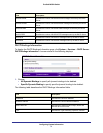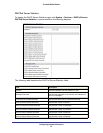
Configuring System Information
59
ProSafe M5300 Switch
• ntp - Relay network time protocol (UDP port 123) packets.
• pim-auto-rp - Relay PIM auto RP (UDP port 496) packets.
• rip - Relay RIP (UDP port 520) packets
• tacacs - Relay TACACS (UDP port 49) packet
• tftp - Relay TFTP (UDP port 69) packets
• time - Relay time service (UDP port 37) packets
• Other - If this option is selected, the UDP Port Other Value is enabled. This option
permits the user to enter their own UDP port in UDP Port Other Value.
4. Use UDP Port Other Value to specify UDP Destination Port that lies between 0 and 65535.
5. Use Discard to enable/disable dropping of matched packets. Enable can be chosen only
when a user enters 0.0.0.0 IP address. Discard mode can be set to Disable when user adds
a new entry with a non-zero IP address.
6. Click ADD to create an entry in UDP Relay Table with the specified configuration.
7. Click DELETE to remove all entries or a specified one from UDP Relay Interface
Configuration Table.
The following table describes the UDP Relay Interface Configuration fields.
Field Description
Hit Count Show the number of UDP packets hitting the UDP
port.
DHCPv6 Server
IPv6 natively provides IP address autoconfiguration through IPv6 Neighbor Discovery
Protocol (NDP) and through the use of Router Advertisement messages. Thus, the role of
DHCPv6 within the network is different than that of DHCPv4 because DHCPv6 is not the
primary source for IP address assignment.
From the DHCP Server link, you can access the following pages:
• DHCPv6 Server Configuration on page 60
• DHCPv6 Pool Configuration on page 60
• DHCPv6 Prefix Delegation Configuration on page 62
• DHCPv6 Interface Configuration on page 63
• DHCPv6 Bindings Information on page 64
• DHCPv6 Server Statistics on page 65


















